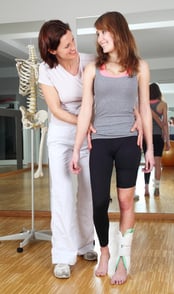 If you suffer from rheumatoid arthritis (RA), you certainly don't need to be told that this disease can make daily life difficult. During a flare, when joints are swollen, stiff, and painful, or in the advanced stages of the disease, when gradual damage to joints impairs their function, even simple, everyday chores, tasks, and activities can become challenging ordeals. Occupational therapy for RA can make living with RA a bit easier, helping you maintain your independence and improve your quality of life.
If you suffer from rheumatoid arthritis (RA), you certainly don't need to be told that this disease can make daily life difficult. During a flare, when joints are swollen, stiff, and painful, or in the advanced stages of the disease, when gradual damage to joints impairs their function, even simple, everyday chores, tasks, and activities can become challenging ordeals. Occupational therapy for RA can make living with RA a bit easier, helping you maintain your independence and improve your quality of life.

What is occupational therapy for rheumatoid arthritis?
Occupational therapy for RA is all about educating sufferers about their disease, helping them learn to manage pain and other RA symptoms, and promoting their ability to do the things they want and need to do as independently as possible. Occupational therapists are thoroughly trained in and have a good working knowledge of anatomy, pathology, and the demands that daily activities place on the body, giving them the knowledge and skill to provide RA sufferers with the education, treatment, and equipment they need to live life to the fullest.
What to expect from occupational therapy
The therapy process begins with an assessment to determine what activities you regularly engage in and which of these are being affected by your RA symptoms. A thorough analysis of your functional abilities will also be done, evaluating factors that include range of motion, strength, exercise tolerance, pain levels, and sensation. You will also be evaluated as to your potential need for orthotics, splints, adaptive equipment, and environmental modifications, at work or at home.
Once these assessments have provided your therapist with a comprehensive picture of your individual needs, an intervention plan will be formulated to address them. Strategies to aid you in managing RA to your best advantage may include:
-
Therapeutic activities to enhance fine motor control, range of motion, exercise tolerance, and strength to improve your level of function
-
Use of heat and cold therapies to aid in pain management
-
Use of techniques such as elevation, compression exercise, and splinting to control symptoms like inflammation and edema
-
Training in joint protection and energy conservation techniques
-
Use of "grabbers" or walking aids and other adaptive equipment to ease difficult tasks and increase independence
-
Activity and/or environmental modifications in the home and/or workplace
-
Use of orthotic devices to help control pain and enhance function
-
Education in stress management techniques
-
Nutritional counseling
The goal of these interventions is to help you learn the self-management skills you need to work around the difficulties and limitations imposed by RA. By learning these skills, you can counter many of the effects of the disease, maintaining or improving your level of mobility and function. So if your rheumatologist has suggested occupational therapy for you, taking that advice can make a substantial difference in your quality of life. If they haven't, request a referral to a local occupational therapy or rehabilitation center for the help you need to live better with RA.




